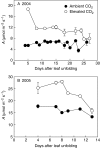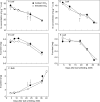Carbon dioxide enrichment does not reduce leaf longevity or alter accumulation of carbon reserves in the woodland spring ephemeral Erythronium americanum
- PMID: 18757450
- PMCID: PMC2712384
- DOI: 10.1093/aob/mcn161
Carbon dioxide enrichment does not reduce leaf longevity or alter accumulation of carbon reserves in the woodland spring ephemeral Erythronium americanum
Abstract
Background and aims: Woodland spring ephemerals exhibit a relatively short epigeous growth period prior to canopy closure. However, it has been suggested that leaf senescence is induced by a reduction in the carbohydrate sink demand, rather than by changes in light availability. To ascertain whether a potentially higher net carbon (C) assimilation rate could shorten leaf lifespan due to an accelerated rate of storage, Erythronium americanum plants were grown under ambient (400 ppm) and elevated (1100 ppm) CO2 concentrations.
Methods: During this growth-chamber experiment, plant biomass, bulb starch concentration and cell size, leaf phenology, gas exchange rates and nutrient concentrations were monitored.
Key results: Plants grown at 1100 ppm CO2 had greater net C assimilation rates than those grown at 400 ppm CO2. However, plant size, final bulb mass, bulb filling rate and timing of leaf senescence did not differ.
Conclusions: Erythronium americanum fixed more C under elevated than under ambient CO2 conditions, but produced plants of similar size. The similar bulb growth rates under both CO2 concentrations suggest that the bulb filling rate is dependant on bulb cell elongation rate, rather than on C availability. Elevated CO2 stimulated leaf and bulb respiratory rates; this might reduce feed-back inhibition of photosynthesis and avoid inducing premature leaf senescence.
Figures





Similar articles
-
Bulb growth potential is independent of leaf longevity for the spring ephemeral Erythronium americanum Ker-Gawl.J Exp Bot. 2023 Jan 1;74(1):489-505. doi: 10.1093/jxb/erac432. J Exp Bot. 2023. PMID: 36308523
-
Source-sink imbalance increases with growth temperature in the spring geophyte Erythronium americanum.J Exp Bot. 2011 Jun;62(10):3467-79. doi: 10.1093/jxb/err020. Epub 2011 Feb 18. J Exp Bot. 2011. PMID: 21335435 Free PMC article.
-
Effects of elevated carbon dioxide concentration on growth and nitrogen fixation in Alnus glutinosa in a long-term field experiment.Tree Physiol. 2003 Oct;23(15):1051-9. doi: 10.1093/treephys/23.15.1051. Tree Physiol. 2003. PMID: 12975129
-
Interaction of nutrient limitation and elevated CO2 concentration on carbon assimilation of a tropical tree seedling (Cedrela odorata).Tree Physiol. 2000 Aug;20(14):977-86. doi: 10.1093/treephys/20.14.977. Tree Physiol. 2000. PMID: 11303573
-
Modelling plant responses to elevated CO2: how important is leaf area index?Ann Bot. 2004 Jun;93(6):619-27. doi: 10.1093/aob/mch101. Epub 2004 Apr 21. Ann Bot. 2004. PMID: 15102613 Free PMC article. Review.
Cited by
-
How do sink and source activities influence the reproduction and vegetative growth of spring ephemeral herbs under different light conditions?J Plant Res. 2014 Jul;127(4):503-11. doi: 10.1007/s10265-014-0640-4. Epub 2014 May 31. J Plant Res. 2014. PMID: 24879401
-
Low temperature maximizes growth of Crocus vernus (L.) Hill via changes in carbon partitioning and corm development.J Exp Bot. 2009;60(7):2203-13. doi: 10.1093/jxb/erp103. Epub 2009 Apr 29. J Exp Bot. 2009. PMID: 19403850 Free PMC article.
References
-
- Ainsworth EA, Long SP. What have we learned from 15 years of free-air CO2 enrichment (FACE)? A meta-analytic review of the responses of photosynthesis, canopy properties and plant production to rising CO2. New Phytologist. 2005;165:351–372. - PubMed
-
- Badri MA, Minchin PEH, Lapointe L. Effects of temperature on the growth of spring ephemerals: Crocus vernus (L.) Hill. Physiologia Plantarum. 2007;130:67–76.
-
- Blakeney AB, Mutton LL. A simple colorimetric method for the determination of sugars in fruit and vegetables. Journal of the Science of Food and Agriculture. 1980;31:889–897.

